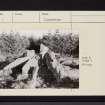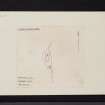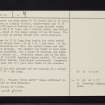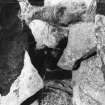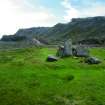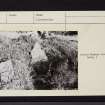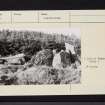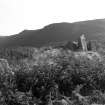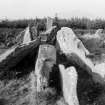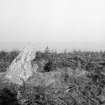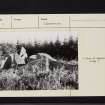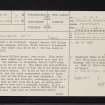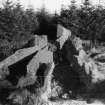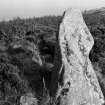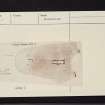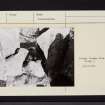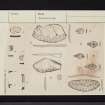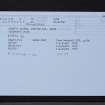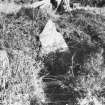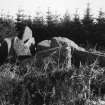Pricing Change
New pricing for orders of material from this site will come into place shortly. Charges for supply of digital images, digitisation on demand, prints and licensing will be altered.
Arran, Whiting Bay, Giant's Graves North
Chambered Cairn (Neolithic), Cremation(S) (Prehistoric), Arrowhead(S) (Flint)(Prehistoric), Beaker(S) (Bronze Age)(Possible), Food Vessel (Prehistoric)(Possible), Knife(S) (Flint)(Prehistoric)
Site Name Arran, Whiting Bay, Giant's Graves North
Classification Chambered Cairn (Neolithic), Cremation(S) (Prehistoric), Arrowhead(S) (Flint)(Prehistoric), Beaker(S) (Bronze Age)(Possible), Food Vessel (Prehistoric)(Possible), Knife(S) (Flint)(Prehistoric)
Canmore ID 40122
Site Number NS02SW 2
NGR NS 04300 24670
Datum OSGB36 - NGR
Permalink http://canmore.org.uk/site/40122
- Council North Ayrshire
- Parish Kilbride
- Former Region Strathclyde
- Former District Cunninghame
- Former County Buteshire
NS02SW 2 04300 24670
(NS 0429 2467 and NS 0430 2463) Giants' Graves (NR)
Cairns (NR)
Human Remains, Pottery, Flint Knives and Arrowheads found AD 1902 (NAT)
OS 6" map, (1924).
For cairn at NS 0430 2463, see also NS02SW 3.
Giants' Graves N: Clyde group, long cairn: This cairn has been much robbed and is now covered with turf and bracken. The surface is irregular, mainly 2-3ft high, but rising to 5ft on the W. The edges are well-defined. The main axis of the cairn is N-S, the N end being wider with a concave facade. The width at the N end has been about 70ft, but the exact measurement cannot be given as the N half of the E side has been disturbed. The sides of the cairn are straight, converging gently to a width of 46ft at 90ft from the N end, at which point there seems to have been a straight facade. In its present form the cairn extends for a further 23ft into a rounded end. The forecourt has been about 41 ft across and 20 ft deep. The NW horn is clearly visible, square-ended and 15 ft wide; the NE horn is defined by a large upright stone, 5ft wide and 4ft high, and a similar stone, now fallen forwards, stood at the inner corner of the NW horn. The forecourt area is partly filled with cairn material.
The chamber is 22ft long from inside the outer portal stones, it varies from 5ft to 2ft 7ins wide. At the time of excavation in 1902, the septal stones and end-stone were missing. The chamber was found to have been previously disturbed, but a layer of charcoal was found along the bottom (Bryce 1903). Artifacts found, now in the NMAS (Acc Nos EO 256-268) included beaker sherds, 'U' pottery sherds, flint knives, leaf-shaped arrowheads. Fragments of burnt bone (EO 271) were also found in the chamber. 33ft S of the main chamber are the remains of a second chamber, 7ft 6ins long.
Source: T H Bryce 1903; J G Callander 1929; A S Henshall 1972, visited 1962.
NS 0429 2467. "Giants' Grave North" (name confirmed) is as described by Miss Henshall.
Surveyed at 1:2500.
Visited by OS (B S) 24 November 1977.
Excavation (14 June 2006 - 15 June 2006)
NS 043 247 AOC Archaeology Group undertook a limited archaeological excavation and survey under the terms of the Historic Scotland Human Remains Call-off Contract between 14 and 15 June 2006. The work was carried out after the reporting to Historic Scotland of an area of disturbance containing burnt bone fragments at the side of the northern cairn of the monument known as Giant's Graves in the SE of Arran. Inspection of the site revealed cremated bone (presumably human) visible on the surface in an irregularly shaped area measuring approximately 2m E-W by 2m N-S adjacent to the W side of the northern cairn. The erosion in this area appears to derive from foot traffic created by the many visitors to the site. A single test pit measuring 1.00 x 0.85m was excavated in the disturbed area and the cremated bone was recovered by sieving. A single sherd of prehistoric pottery and a retouched flint were recovered from the excavation area. The deposits subject to the erosion probably derive from antiquarian excavation in the late 19th century.
Archive to be deposited with NMRS.
Sponsor: Historic Scotland.
M Roy 2006
Condition Survey (8 September 2014 - 12 September 2014)
AOC Archaeology Group undertook a survey of seven chambered cairns and one four poster stone circle on Arran was undertaken for the purposes of providing a baseline record, for conservation management and for archaeological study.
Information from OASIS ID: aocarcha1-200509 (G Cavers) 2014
Note (3 July 2018)
The location, classification and period of this site have been reviewed.
HES Survey and Recording 3 July 2018































